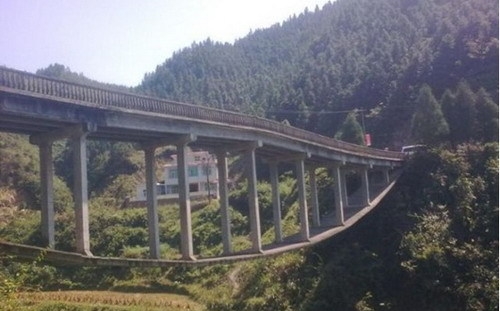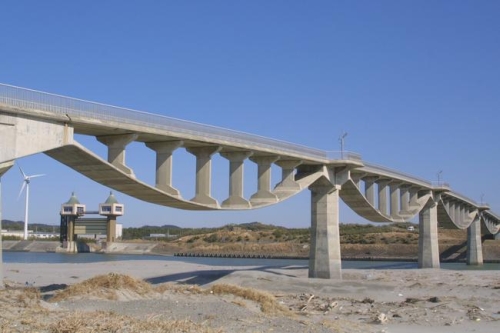가끔 refer를 통해 유입경로를 확인하는데 아래 교량과 관련하여 Seiun Bridge를 링크한 글들이 부쩍 눈에 띤다.

네티즌들이 윗 교량을 ‘대륙의 교량’ 혹은 영화 아바타(avatar)에서나 나올 법한 공중 부양 ‘아바타 교량’이라 칭하며 웃음거리로 비하하는데 궁금한 것은 전문가들도 아닌데 교량 사진만 보고 구조형식이 조상판형교라는 것을 어떻게 알고 관련 글을 링크하는지 그 열정에 탄복하지 아니할 수 없다. 🙂 이 교량에 대한 정보를 웹에서 찾을 수가 없어 자세한 소개를 할 수는 없고,

대륙의 교량이 카피했는지 모르겠지만 가장 유사한 형태의 교량으로 1995년 전중상을 받은 Shiosai Bridge(潮騷橋)를 꼽을 수 있다. Structurae 에선 구조형식을 lenticular type이라 표기했는데 모양을 보고 명한 것 뿐 정확한 구조 형식은 Stress Ribbon Type 중 하나이다. 좀 색다른 형식으론 사장교와 접목을 한 Ayumi Bridge가 있다.
Shiosai Bridge 관련한 학술자료 중 일부에서 발췌를 했다. ‘일본의 최근 PSC 교량 기술’이라는 제하로 몇가지 교량 형식들을 소개하는데 10년도 더 된 기술력들을 우려 먹고 있다. 🙂 그래도 교량에 관해선 일본만큼 열심히 공부하는 나라도 없을 것이다.
The Shiosai Bridge in Shizuoka, Japan, is a prestressed concrete four-span stress-ribbon bridge with roadway slab decks, which forms a so-called inverted suspension bridge as shown in Figure 20 [10]. The bridge, for cyclists and pedestrians, was completed in 1995. The superstructure consists of roadway slab decks, columns which support the slab decks, and stress ribbons forming the lower cord. The bridge length is 232 m, the clear width is 3.0 m, and the span lengths are 55, 61, 61 and 55 m.
In this structure, loads are transferred via the slab decks into the columns, which are supported by the stress ribbons that in turn are supported by the piers and butments. Overall stiffness was increased using elastic connections with horizontal neoprene bearings, which were installed between the ends of the roadway slabs and the abutments. Most of the superstructures were precast using lightweight concrete, in order to minimize the horizontal forces acting on the abutments, thus making the structure more economical. To ensure corrosion protection, epoxy-coated prestressing strands were used for bearing cables and prestressing cables for the stress ribbon. [Recent technology of prestressed concrete bridges in Japan]
Updated : 대륙의 교량은 Taojin Bridge이다. 다른 링크